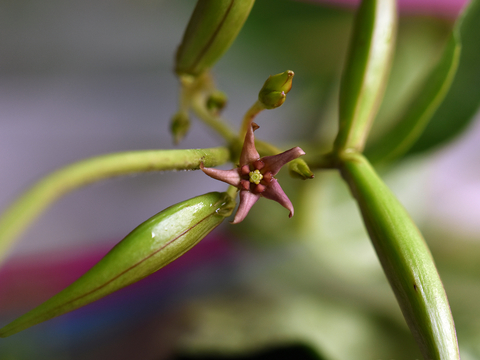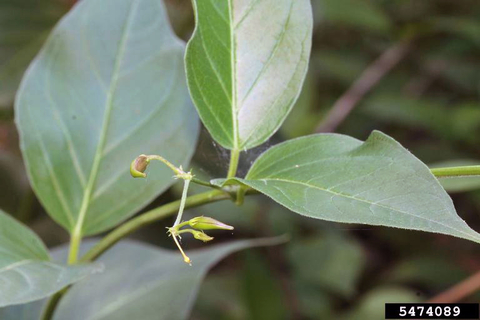Quick facts
Pale swallow-wort (Cynanchum rossicum, also known as Vincetoxicum rossicum) is a non-native plant that has been found in Minnesota.
- Pale swallow-wort is an herbaceous perennial vining milkweed originating from Southern Europe.
- Leaves are believed to be fatal to monarch caterpillars who mistake them for native milkweeds.
- Please report this species so we can better understand its distribution in the wild. Report to Minnesota Department of Agriculture Report a Pest.
How to identify pale swallow-wort
- Stems: Herbaceous vines that twine around adjacent structures. Vine can grow up to 6 feet long and above-ground parts die back each winter.
- Leaves: Opposite, lanced shaped with smooth edges, dark green and glossy.
- Flowers: Five long and curled petals, white to light pink to purple.
- Fruit: Long, smooth and slender pod clusters similar to black swallow-wort. When mature, the pods open to release rounded and flattened brown seeds with silky filament.
- Roots: Fleshy with a thickly budded rhizomatous crown just below the soil surface.
Common look-alikes
Swamp milkweed (Asclepias incarnata var. Incarnata) is a native common in sunny, wet, moist habitats. Leaves are slender and smooth. It can grow up to 3-4 feet tall and has showy pink flowers from June-August.
Common milkweed (Asclepias syriaca) is a native, perennial herbaceous plant in the milkweed family. It commonly grows in sunny areas and ditches and is a primary part of the monarch butterfly’s diet. Leaves are oval and opposite and plants can grow up to 5 feet tall. Flowers develop at the top of the stem in an umble pattern and are typically light pink. Seed pods mature late in the fall.
Black swallow-wort (Cynanchum louiseae) is an herbaceous perennial vine on Minnesota’s Prohibited - Eradicate noxious weed list. Vines can grow 6 feet long and in a variety of habitats including full sun, and full shade. Flowers have 5 dark purple petals and are 1/8 inch with a yellow center. Seed pods are smooth and slender, 2.5 inches long.
Rough potato (Metaplexis japonica) is an herbaceous perennial vining milkweed originating from eastern Asia. Its vines can be up to 25 feet long and die each winter. It has opposite heart-shaped leaves and pale pink, five-petaled flowers that curl back.
Reporting and controlling pale swallow-wort
Please report pale swallow-wort. As with all non-native species found in unmanaged areas, report findings of this species using one of the following methods:
- Use the Great Lakes Early Detection Network (GLEDN) free mobile app (preferred). Species listed as dog-strangling vine, Vincetoxicum rossicum in the app.
- Report using the EDDMapS Midwest web-based mapping system for documenting invasive species. Species listed as dog-strangling vine, Vincetoxicum rossicum on the website.
- Report to Minnesota Department of Agriculture Report a Pest.
Management
Pale swallow-wort is similar to black swallow-wort and management is similar.
- Cultivation: Pale swallow-wort generally doesn’t persist in crops that are cultivated annually.
- Mechanical control: Pale swallow-wort easily breaks when hand-pulled. Roots can be dug out and disposed of, but continual monitoring is necessary. Mowing is not recommended as it is likely to spread seeds.
- Herbicide control: Spot spray leaves with glyphosate, triclopyr, or imazapyr while the plant is flowering. For smaller populations, herbicide can be applied directly to a cut stem.
Reviewed in 2021



